Whether you realize it or not, we experience curriculum every single day. Curriculum influences the most obvious learning situations like classroom lessons and workplace training sessions, but it also influences a variety of less-obvious situations such as how we learn about products, how we learn from online tutorials (yes, to an extent this applies to using YouTube to fix a leaky faucet!), and how organizations plan large-scale change efforts. Curriculum influences how people learn and grow from very young ages and continues to shape learning experiences throughout our lives.
The purpose of this chapter is to provide a survey of curriculum design processes across diverse educational and professional contexts and to highlight essential curriculum design skills embedded in these processes. Curriculum design is a core pillar of how we educate, train, and engage in formal learning experiences. At the core of curriculum design is a mental model for how people learn and a design representation for how knowledge and skill transfer occurs from theory into practice.
For emerging professionals in the instructional design field, curriculum design is one of a series of core competencies that are necessary for professional success (Burning Glass, 2019). In the most basic of terms, curriculum design is the process of planning formal learning experiences. Yet, there are many tacit criteria that differentiate between effective and ineffective curriculum design processes. For the purposes of this chapter, we will examine curriculum design as a strategic-level process for how learning experiences are designed. This differentiates from instructional design processes, which tend to involve more operational-level processes. For example, you can differentiate curriculum design from instructional design as curriculum design is more “big picture thinking” while instructional design is concerned with more tactical decisions within instructional materials and interactions.
Defining Curriculum Design
Curriculum design is operationally defined for this chapter as the intentional planning, organization, and design of learning strategies, processes, materials, and experiences towards defined learning and/or performance outcomes. Curriculum design is concerned with much more than learning materials. In one sense, curriculum design is creating a holistic plan for the environments where learning happens. This includes considering the physical, digital, social, and psychological factors that define the spaces and places where people learn (American Educational Research Association, n.d.).
Figure 1
Diagram Illustrating Elements of Curriculum Design vs. Instructional Design
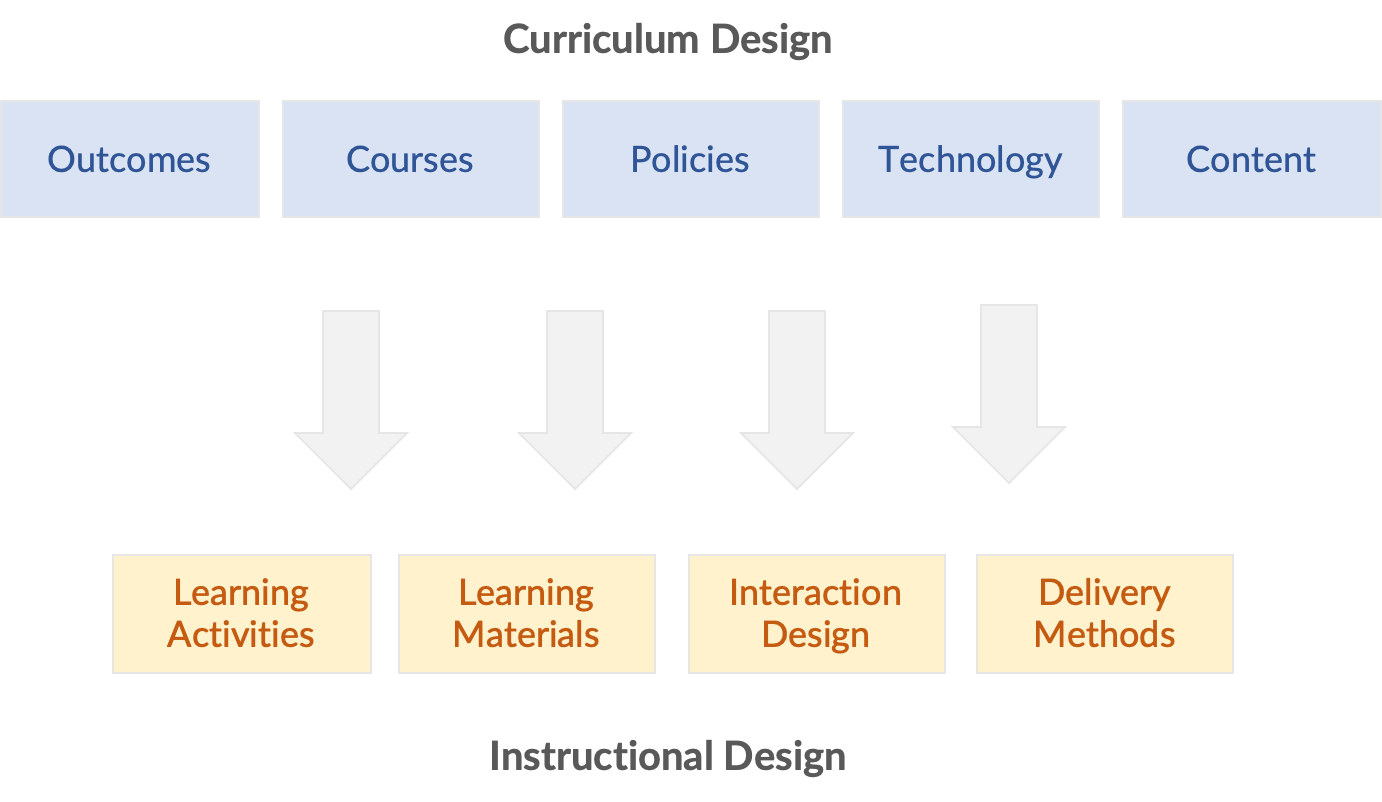
Curriculum design is a team sport. The teams who engage in curriculum design processes are comprised of people with diverse areas of expertise. Typically, a curriculum design team will include subject matter experts (e.g. faculty member), curriculum coordinator/director, curriculum oversight groups, instructional design and development specialists, and teaching/facilitation personnel. Depending on the nature of the curriculum, this can also include information technology specialists, organizational development specialists, data and research specialists, and senior leadership.
Figure 2
Diagram Illustrating an Example Curriculum Design Team
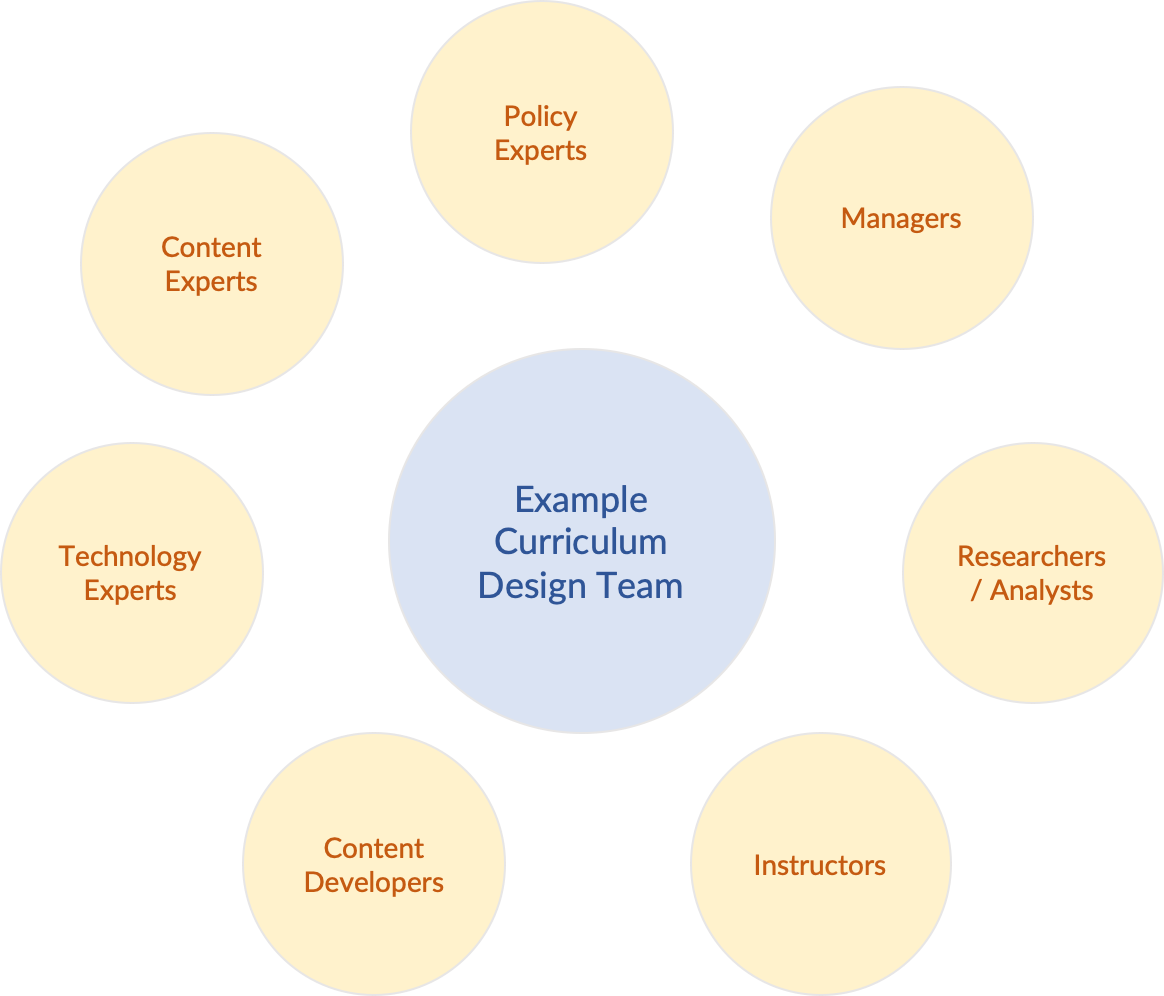
Curriculum design, when done well, is a process that is collaborative, results-oriented and transforms diverse ideas into a focused vision for learning.
Designing Curriculum with the End in Mind
The primary goal of curriculum design is aligning learning strategies, materials, and experiences to defined outcomes. From this standpoint, good curriculum should be results-focused and efficient. To accomplish this, curriculum designers often use tools such as learner personas, needs analysis, and existing assessment data to determine the scope of a project. From there, it becomes important to develop learning strategies that connect to the characteristics of the intended learners to help them reach the desired outcomes.
Designing curriculum with the end in mind involves managing, designing, and organizing learning objectives, competencies, and standards within a curriculum. The process of designing curriculum with the end in mind is commonly referred to as “backward design” (Wiggins & McTighe, 1998). The major concept important to curriculum designers is that instead of starting with content or topics (common historical practice by many educators), backward design starts with the outcomes and then works backwards to address the content, topics, strategies, and materials.
Figure 3
Diagram Comparing Design Approaches
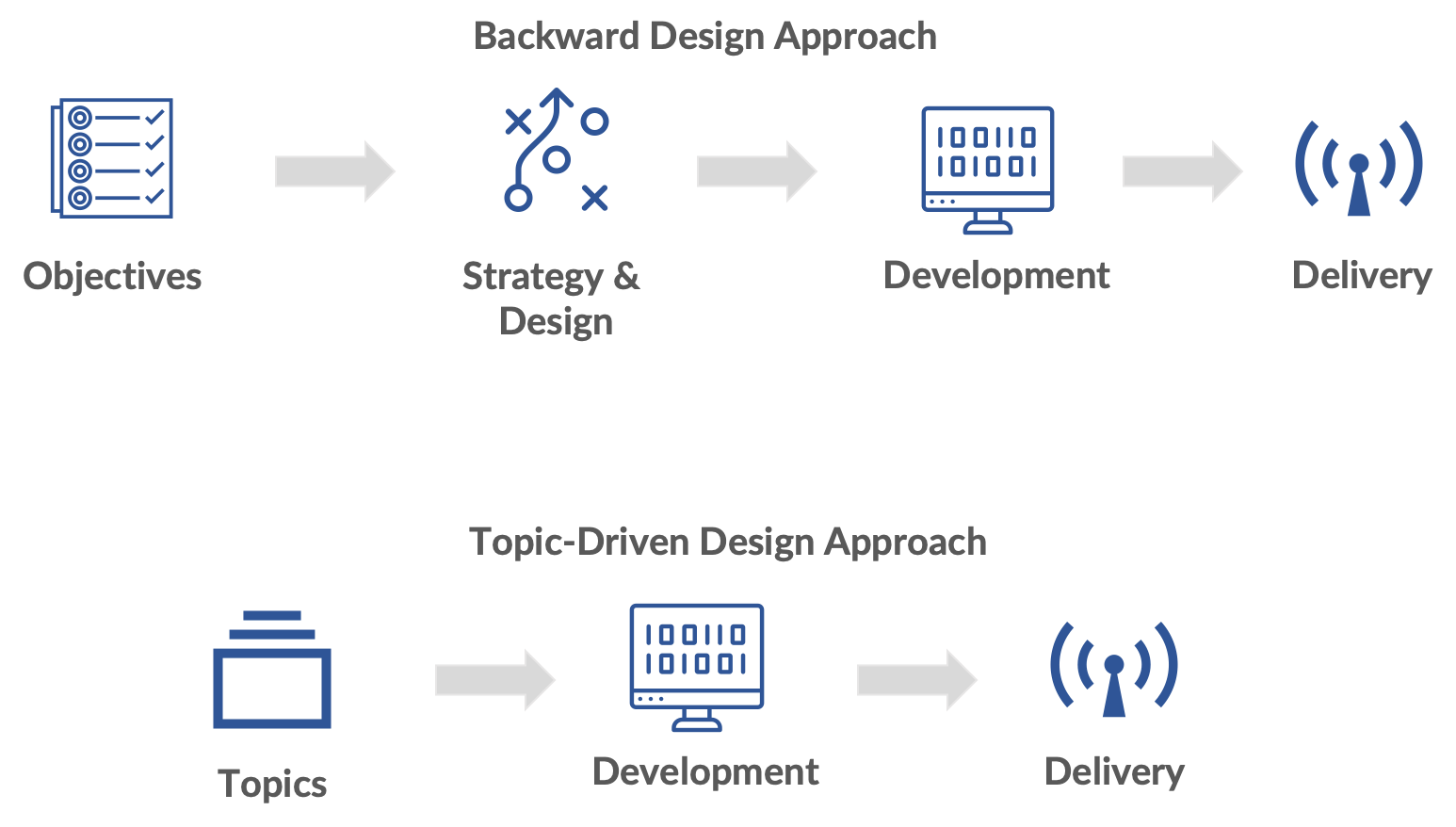
One of the key tools important to backward design is the use of learning objectives taxonomies. One of the most widely used of these taxonomies is Bloom’s Taxonomy (Bloom, 1956). Bloom’s Taxonomy organizes learning objectives based on a “level of learning.” The revised version classifies these as: remember, understand, apply, analyze, evaluate, and create. These levels describe cognitive learning processes that are demonstrated through various forms of behaviors.
Figure 4
Bloom's Taxonomy (Source: https://edtechbooks.org/-dpW)
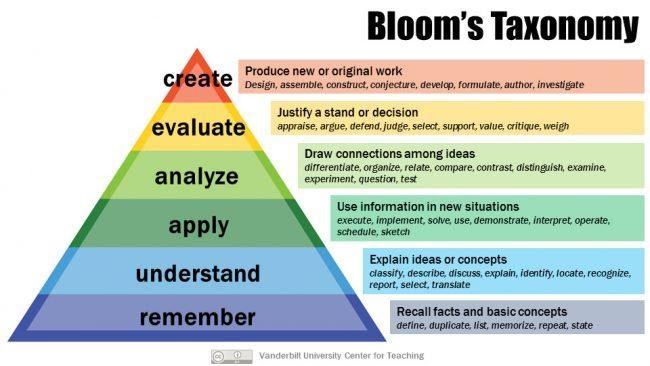
Taxonomies like Bloom’s provide a framework for organizing types of learning outcomes and selecting appropriate curriculum strategies for a specific level of learning. For example, a learning objective at the understand level will likely be designed far differently than an objective at the evaluate or create levels. This not only influences the types of strategies used, but also the alignment of curriculum elements and appropriate level of learner (i.e. novice, intermediate, advanced).
Standards and competency frameworks are common resources curriculum designers use in the process of conducting their work. These frameworks vary across countries and disciplines; however, they often serve a common purpose of aligning curriculum to common outcomes and learning/performance goals (e.g. Common Core Standards, Talent Develop Capability Model).
Representing and Mapping Curriculum
Curriculum design can be a complex process that includes many different forms of data, information, and goals. On a practical level, curriculum designers often use forms of representations or diagrams to help manage the complexity and decision-making processes. Curriculum representations provide a method for communicating and collaborating with others during the curriculum design process. This often includes representing plans for how curriculum will be organized and made available to the learner.
When mapping curriculum, there are several major and interdependent variables of curriculum that can be important to visualize. These variables are referred to as design “layers” (Gibbons, 2014). While there can be many different aspects important to represent in curriculum design processes, the following list outlines major considerations, or design variables.
- Outcomes—the intended learning or performance result from the curriculum
- Content—the topics or information included in the curriculum
- Instructional Strategies—how the curriculum is organized, structured, and/or presented to achieve a defined result
- Technology—the digital or analog tools used to support the curriculum delivery, development, or assessment
- Data—how metrics and data elements are captured, organized, stored, and represented
- Media—the physical or digital assets used to present curriculum to the learner
- Policy—the guiding principles, rules, or regulations that frame the design of the curriculum
These “layers” represent the essential variables that effective curriculum designers consider when working on curriculum projects and initiatives. Each of these layers are interdependent and should be considered in concert with one another and not independently. For example, both outcomes and content should align to ensure the content being presented supports learners as they work towards achieving specified learning outcomes.
In the process of designing curriculum layers, curriculum designers often use representation tools and methods to organize ideas and communicate this information to stakeholders. While there are many different approaches to representing curriculum, the following list highlights common frameworks used in the curriculum design field.
- “The Canvas.” Canvas tools are analog or digital documents that organize various elements of curriculum design decisions in a single visual field. The purpose of curriculum canvas documents is to provide a structured way of organizing ideas at a conceptual level and establishing a common vision for the curriculum. Canvas tools are often used to support collaboration and brainstorming processes; however, they can also be used as a way to organize individual ideas and communicate those to others in structured ways.
Figure 5
Conceptual illustration of a Canvas Curriculum Planning Tool
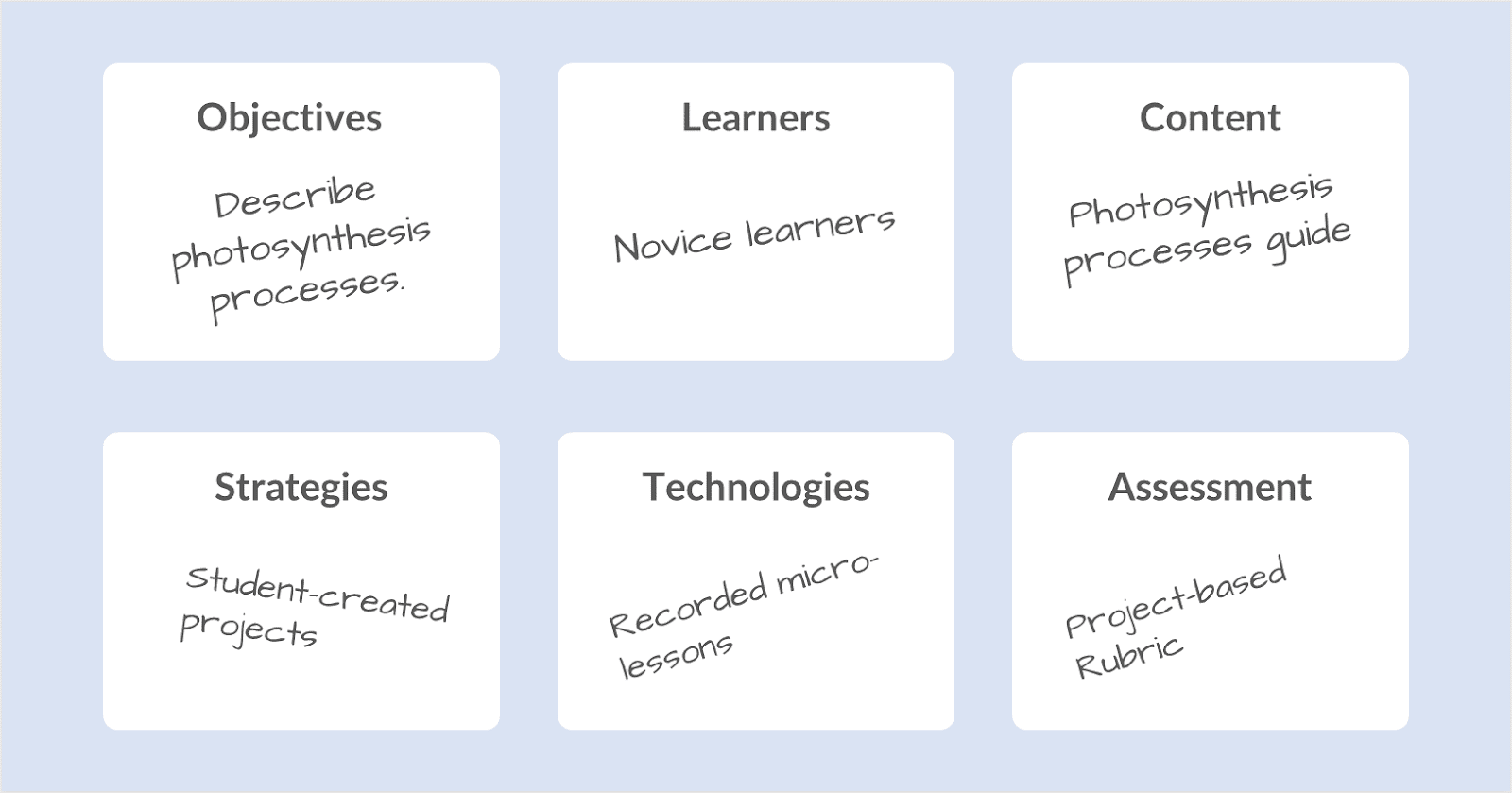
Visit http://www.lxcanvas.com/ for an example of a canvas-based curriculum design tool. The following video explains the elements of the Learning Experience Canvas.
- “The Lesson Plan.” Lesson plans are one of the most common forms of curriculum representations across various education and training contexts. There are many, many different formats and approaches to creating curriculum lesson plans. These can range from simple outlines, to structured documents that represent many elements of curriculum including learning outcomes, instructional sequence, facilitator prompts, time markers, and teaching notes. How a lesson plan should be created is largely dependent on the intended uses and audiences for the documents.
Figure 6
Conceptual Illustration of a Lesson Plan

Visit https://edtechbooks.org/-TTeu for example lesson plan formats.
- “The Curriculum Matrix.” Curriculum matrices are documents that represent relationships and alignment between key variables in the curriculum. This representation is often presented as crosstabulation tables that have one variable across the top row and another down the left column. Next, relationship indicators are placed in the interesting cells to show a relationship between the two variable elements. A curriculum matrix representation is commonly used to show how learning outcomes are represented across courses or units in the curriculum.
Figure 7
Conceptual Illustration of a Curriculum Matrix
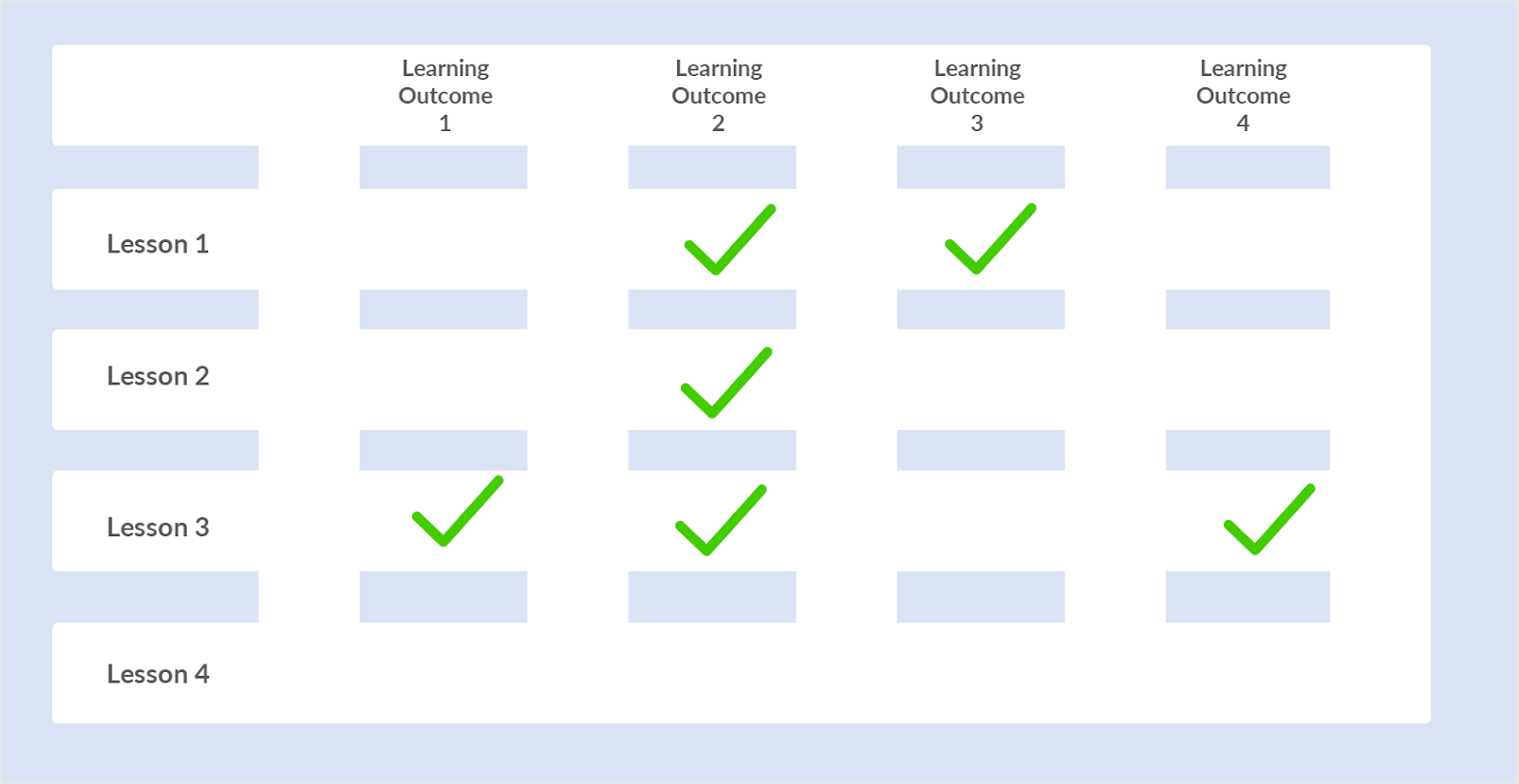
Visit https://edtechbooks.org/-Jewdb for an example curriculum matrix.
- “The Blueprint.” Blueprint-style curriculum representations integrate a number of design variables in a single diagram, or “blueprint.” The primary purpose of this type of representation is to create documentation that can be used to develop and implement curriculum. Blueprint representations often contain instructional elements organized in segments and sequences as well as production notes to guide how the curriculum should be developed and/or implemented. They often also represent relationships between the various curriculum elements. For example, a blueprint may note that a learner must complete a certain set of exercises successfully at a given mastery level before progressing to the next set of exercises. The blueprint represents the curriculum design strategy in an actionable format.
Figure 8
Conceptual Illustration of a Blueprint Curriculum Diagram

Visit https://edtechbooks.org/-LyV for an example curriculum blueprint.
Comparing and Selecting Curriculum Mapping Tools
Selecting the most appropriate curriculum mapping method is often determined based on the current phase and goals of the curriculum design process. The following table compares the curriculum mapping tools discussed in this chapter and presents selection considerations.
Table 1
Comparison of Curriculum Mapping Tools
| |
Canvas |
Lesson Plan |
Matrix |
Blueprint |
|---|
| Uses |
Use early in the design process for brainstorming and ideation |
Use to plan and facilitate specific lessons |
Use to align curriculum to outcomes
Use for assessment of learning outcomes |
Use to plan the sequence and arrangement of curriculum |
|---|
| Pros |
Encourage group collaboration and interaction |
Common format for many professionals in education and training |
Clearly shows alignment between curriculum and outcomes |
Visually shows curriculum elements, flows, and sequence. |
|---|
| Cons |
Can lack specifics needed to implement curriculum |
Some may see lesson plan as limiting creativity or adaptability of curriculum |
Some matrix documents can be very complex which may limit their application in practice |
Blueprints can be visually complex and unfamiliar for some audiences. |
|---|
Learning Environment Modeling™—A Method for Creating Curriculum Blueprints
A particularly critical challenge faced by many curriculum designers is the lack of a generally accepted design language and system in the field (Gibbons, 2014). For example, many design professions have a language to represent their work so that the audience versed in the language can easily understand and build from their work. Architects, engineers, and software programmers are all examples of professionals that use design languages to communicate ideas.
Learning Environment Modeling™ was created to advance a solution to the absence of a shared design language for curriculum and instructional design. At the core of Learning Environment Modeling™ is a language that represents five “building blocks” of curriculum, four learning contexts, three transitional actions, and two standard notations. These language elements are combined together in a blueprint that shows how the curriculum is to be organized and implemented.
Visit https://edtechbooks.org/-rqn to learn more about Learning Environment Modeling™ and how it can be used to design curriculum.
Over the previous several years, a number of digital platforms have become available on the market to manage curriculum design processes. While these platforms vary in strategy, most seek to increase efficiency and provide a common digital hub for managing information and communication about curriculum processes. These platforms are currently distinct from content authoring tools used for creating materials, in that they focus solely on the curriculum organization and design, rather than content development and delivery. In addition to standalone curriculum design platforms, many learning management systems are incorporating similar features as part of their capabilities.
Examples of Curriculum Design Platforms
Examples of Learning Management Systems with Integrated Curriculum Design Capabilities
Innovation Considerations for Curriculum Design Processes
As innovations in learning design and technology are created and scaled, curriculum design processes must adapt to ensure these methods remain grounded in effective learning practices. This section discusses several innovation trends and their possible implications on curriculum design processes.
One of the foundational innovations influencing curriculum design processes is a shift from individual-focused design to team-based curriculum design. Curriculum design is becoming more and more a “team sport” where people from diverse backgrounds, professions, and areas of expertise work together to create curriculum. The increasing influence of technology continues to not only incorporate new backgrounds (e.g. technologists), but also allows people from all around the world to collaborate on curriculum more efficiently. Successful curriculum design professionals are master facilitators across different types of contexts and through the effective use of collaborative technologies.
In addition to curriculum design becoming more collaborative, it is also becoming a more strategic and holistic activity. Traditionally curriculum was viewed like a product that was self-contained and independent. As such, curriculum design processes mirrored product development cycles and approaches. As organizations, learning needs, and technologies change, curriculum design is moving more towards a holistic perspective of learning environment design. This mindset goes beyond curriculum as a product, and more about designing the collective spaces and places where people learn at a strategic level. While this may seem like semantics at first, the implications for how curriculum is designed and connected with other elements in a learning environment is profound.
Moving from curriculum design to learning environment design requires a systems thinking perspective that involves not only designing elements in the learning environment, but also designing how those elements interact together. A good example of this is the emergence of blended learning as a common instructional practice. Blended learning is the combination of classroom and digital learning experience in a unified strategy. Curriculum designers must not only be considered with the design of classroom curriculum and digital curriculum, but also how they interact together in a unified learning environment.
The broad adoption of mobile devices have also caused innovations in curriculum design. For example, designing curriculum that is responsive across different types of devices with different screen sizes is a basic innovation influencing the field. In addition, designing curriculum for other mobile device features such as geo-positioning, imaging, and content creation capabilities offer exciting and often challenging situations. Many modern mobile devices now have immersive virtual space capabilities such as virtual reality and augmented reality. These capabilities highlight the need for new curriculum design approaches that have not traditionally been required. Mobile and extended reality learning capabilities will continue to be a major consideration for tomorrow’s curriculum designers.
In addition to collaborative design processes, mobile learning, and extended reality innovations, one of the more profound innovations influencing curriculum design processes is adaptive learning. Adaptive learning is a general concept that describes the process of providing learners with dynamic learning experiences based on their prior performance (Educause, 2017). This is commonly used for recommending remediated learning experiences and encouraging peak learning performance. The reason adaptive learning is such a profound innovation for curriculum design processes is because it introduces the dynamic layers that have not traditionally been used. For example, a curriculum designer would create a defined path for learners to follow based on assumptions and requirements set forth in the design process. Adaptive learning shifts this decision making to programmatic algorithms or a more complex map of learning experience options. This requires curriculum designers to think and make design decisions about much more complex and dynamic learning environments.
Conclusion
Curriculum design processes are essential to effective learning experiences across education and professional contexts. Without effective curriculum design processes, learners often lack the structure and guidance necessary for optimal learning and organizations lack the ability to effectively measure results and optimize their return on investments. While we have all experienced curriculum, the process of designing curriculum is changing, becoming more complex, and incorporating new technologies and strategies. One of the most profound shifts is expanding the scope of curriculum design to consider how curriculum connects to broader and more networked learning environments. Curriculum design is an essential skill for emerging education and learning professionals and will continue to be a dynamic, innovative, and exciting field of practice for years to come.
References
American Educational Research Association (n.d.). Learning Environments SIG 120. Retrieved from https://edtechbooks.org/-CKj
Bloom, B.S. (1956). Taxonomy of educational objectives: The classification of educational goals. New York, NY: Longmans, Green.
Burning Glass (2019). Program Insights [Electronic Database]. Retrieved from https://www.burning-glass.com/
Educause (2017). Seven Things You Should Know About Adaptive Learning. Retrieved from https://edtechbooks.org/-gvaK
Gibbons, A. S. (2014). An architectural approach to instructional design. New York, NY: Routledge.
Wiggins, G. P., & McTighe, J. (2005). Understanding by design.